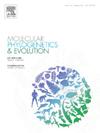全基因组分析提供了对昆虫病原线虫属Heterorhabditis的遗传变异、系统发育和共系统发育关系以及生物地理学的见解。
IF 3.6
1区 生物学
Q2 BIOCHEMISTRY & MOLECULAR BIOLOGY
引用次数: 0
摘要
多基因、全属的系统发育研究发现,常用的基因标记,特别是rRNA基因,在区分异虫线虫属近缘种方面的分类学分辨力有限。此外,使用不同的基因标记常常获得相互冲突的树拓扑,这限制了我们对昆虫病原线虫属Heterorhabditis的种系和共系统发育关系和生物地理学的理解。在这里,我们使用全核和线粒体基因组以及整个核糖体操纵子序列进行系统发育重建,以及使用各种单核和线粒体基因进行多重系统发育重建。利用推断出的系统发育关系,研究了异habditis及其光habdus细菌共生体之间的共系统发育关系和生物地理格局。利用整个核基因组和线粒体基因组重建了强大的、解决得很好的、高度一致的系统发育关系。同样,整个核糖体操纵子序列被证明对系统基因组重建是有价值的,尽管它们对区分近亲物种的价值有限。此外,两个线粒体基因,细胞色素c氧化酶亚基I (cox-1)和NADH脱氢酶亚基4 (nad-4),以及两个管家基因,fanconi相关核酸酶1 (fani -1)和丝氨酸/苏氨酸蛋白磷酸酶4调节亚基1 (ppfr-1),与其他单个基因相比,提供了最强大的系统发育重建。根据我们的研究结果,强烈建议用全核和/或线粒体基因组来重建异habditis属的系统发育关系。如果没有完整的核和/或线粒体基因组,可以使用核和线粒体基因的组合作为替代。在这种情况下,在全属系统发育背景下,应该分析多个同种分离物的序列,以避免线粒体基因的高种内序列差异导致的人工物种过度分裂,避免一些核基因的低种间序列差异导致的人工物种聚集。另一方面,我们观察到Heterorhabditis属和Photorhabdus属表现出不同的生物地理模式,从世界性物种到潜在的特有物种,尽管也发生了寄主切换,但系统发育一致性很高。我们的研究有助于更好地了解一类重要的生物防治剂的生物多样性和系统发育关系,并推动我们开发更多与可持续和生态友好农业实践兼容的工具。本文章由计算机程序翻译,如有差异,请以英文原文为准。

Genome-wide analyses provide insights into genetic variation, phylo- and co-phylogenetic relationships, and biogeography of the entomopathogenic nematode genus Heterorhabditis
Multigene, genus-wide phylogenetic studies have uncovered the limited taxonomic resolution power of commonly used gene markers, particularly of rRNA genes, to discriminate closely related species of the nematode genus Heterorhabditis. In addition, conflicting tree topologies are often obtained using the different gene markers, which limits our understanding of the phylo- and co-phylogenetic relationships and biogeography of the entomopathogenic nematode genus Heterorhabditis. Here we carried out phylogenomic reconstructions using whole nuclear and mitochondrial genomes, and whole ribosomal operon sequences, as well as multiple phylogenetic reconstructions using various single nuclear and mitochondrial genes. Using the inferred phylogenies, we then investigated co-phylogenetic relationships between Heterorhabditis and their Photorhabdus bacterial symbionts and biogeographical patterns. Robust, well-resolved, and highly congruent phylogenetic relationships were reconstructed using both whole nuclear and mitochondrial genomes. Similarly, whole ribosomal operon sequences proved valuable for phylogenomic reconstructions, though they have limited value to discriminate closely related species. In addition, two mitochondrial genes, the cytochrome c oxidase subunit I (cox-1) and the NADH dehydrogenase subunit 4 (nad-4), and two housekeeping genes, the fanconi-associated nuclease 1 (fan-1) and the serine/threonine-protein phosphatase 4 regulatory subunit 1 (ppfr-1), provided the most robust phylogenetic reconstructions compared to other individual genes. According to our findings, whole nuclear and/or mitochondrial genomes are strongly recommended for reconstructing phylogenetic relationships of the genus Heterorhabditis. If whole nuclear and/or mitochondrial genomes are unavailable, a combination of nuclear and mitochondrial genes can be used as an alternative. Under these circumstances, sequences of multiple conspecific isolates in a genus-wide phylogenetic context should be analyzed to avoid artefactual species over-splitting driven by the high intraspecific sequence divergence of mitochondrial genes and to avoid artefactual species lumping driven by the low interspecific sequence divergence of some nuclear genes. On the other hand, we observed that the genera Heterorhabditis and Photorhabdus exhibit diverse biogeographic patterns, ranging from cosmopolitan species to potentially endemic species, and show high phylogenetic congruence, although host switches have also occurred. Our study contributes to a better understanding of the biodiversity and phylo- and co-phylogenetic relationships of an important group of biological control agents and advances our efforts to develop more tools that are compatible with sustainable and eco-friendly agricultural practices.
求助全文
通过发布文献求助,成功后即可免费获取论文全文。
去求助
来源期刊
CiteScore
7.50
自引率
7.30%
发文量
249
审稿时长
7.5 months
期刊介绍:
Molecular Phylogenetics and Evolution is dedicated to bringing Darwin''s dream within grasp - to "have fairly true genealogical trees of each great kingdom of Nature." The journal provides a forum for molecular studies that advance our understanding of phylogeny and evolution, further the development of phylogenetically more accurate taxonomic classifications, and ultimately bring a unified classification for all the ramifying lines of life. Phylogeographic studies will be considered for publication if they offer EXCEPTIONAL theoretical or empirical advances.

 求助内容:
求助内容: 应助结果提醒方式:
应助结果提醒方式:


